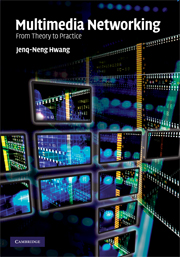Book contents
- Frontmatter
- Contents
- Preface
- Acknowledgements
- List of abbreviations
- 1 Introduction to multimedia networking
- 2 Digital speech coding
- 3 Digital audio coding
- 4 Digital image coding
- 5 Digital video coding
- 6 Digital multimedia broadcasting
- 7 Multimedia quality of service of IP networks
- 8 Quality of service issues in streaming architectures
- 9 Wireless broadband and quality of service
- 10 Multimedia over wireless broadband
- 11 Digital rights management of multimedia
- 12 Implementations of multimedia networking
- Index
11 - Digital rights management of multimedia
Published online by Cambridge University Press: 26 January 2010
- Frontmatter
- Contents
- Preface
- Acknowledgements
- List of abbreviations
- 1 Introduction to multimedia networking
- 2 Digital speech coding
- 3 Digital audio coding
- 4 Digital image coding
- 5 Digital video coding
- 6 Digital multimedia broadcasting
- 7 Multimedia quality of service of IP networks
- 8 Quality of service issues in streaming architectures
- 9 Wireless broadband and quality of service
- 10 Multimedia over wireless broadband
- 11 Digital rights management of multimedia
- 12 Implementations of multimedia networking
- Index
Summary
Owing to the proliferation of digitized media applications, such as e-Book, streaming videos, web images, shared music, etc., there is a growing need to protect the intellectual property rights of digital media and prevent illegal copying and falsification. This explains the strong demand for digital rights management (DRM), which is an access control technology that protects and enforces the rights associated with the use of digital content, such as multimedia data. The most important functions of DRM are to prevent unauthorized access and the creation of unauthorized copies of digital content, and moreover to provide a mechanism by which copies can be detected and traced (content tracking). Digital rights management is the most critical component of the intellectual property management and protection (IPMP) protocol widely promoted in the MPEG standards. Under the IPMP's scope, intellectual property (IP) is anything whose use owes the inventors or the owners some form of compensation. This could be a particular media application or it could be the technology used by the media. The management of IP involves storage and serving, appropriate authorization of use, and correct billing and tracking. The protection of IP prevents unauthorized use or misuse of the IP and can make legitimate use easy. According to [1], an effective DRM system should have the following four requirements.
(1) The DRM system must package the content to be protected in a secure manner.
(2) The DRM system must obtain the access conditions (license) specified by the owner of the protected content.
(3) The DRM system must determine whether the access conditions have been fulfilled
[…]
- Type
- Chapter
- Information
- Multimedia NetworkingFrom Theory to Practice, pp. 410 - 466Publisher: Cambridge University PressPrint publication year: 2009



